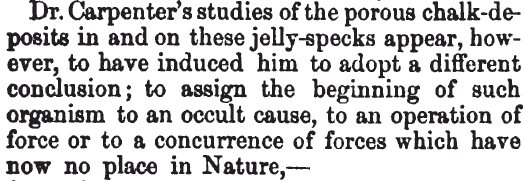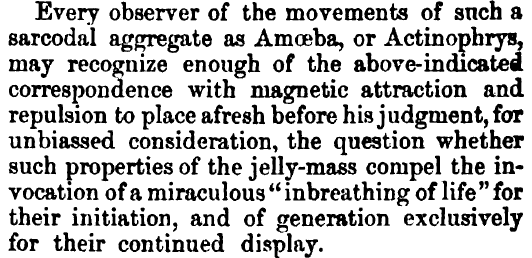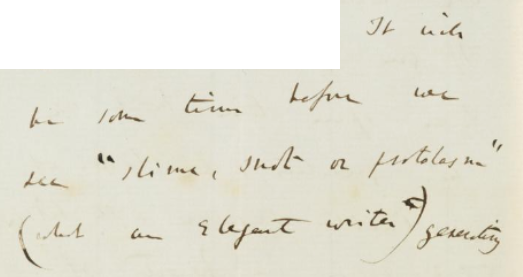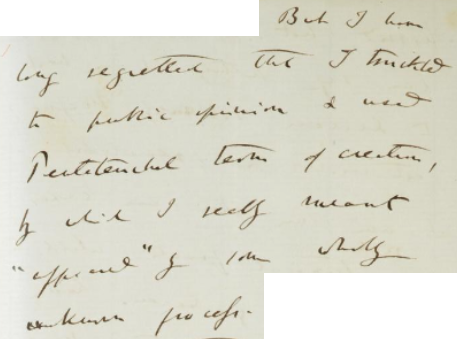In my last post, I described the account Darwin gave in his Origin of Species of the initial appearance of life on earth. In the first edition he said that life had been ‘breathed’ into a few forms or one, and in subsequent editions he added that the breath was imparted ‘by the Creator’.
The idea of life being imparted by breath comes from Genesis 2.8:
וַיִּיצֶר֩ יְהוָ֨ה אֱלֹהִ֜ים אֶת־הָֽאָדָ֗ם עָפָר֙ מִן־הָ֣אֲדָמָ֔ה וַיִּפַּ֥ח בְּאַפָּ֖יו נִשְׁמַ֣ת חַיִּ֑ים וַֽיְהִ֥י הָֽאָדָ֖ם לְנֶ֥פֶשׁ חַיָּֽה׃
And the LORD God formed man of the dust of the ground, and breathed into his nostrils the breath of life; and man became a living soul. [King James Version]
as Darwin acknowledged in a letter to his close friend Joseph Hooker dated 29 March 1863. Hooker had sent Darwin his copy of the Athenaeum, dated one day earlier. It contained (pp 417-9) a review of a book by William B. Carpenter on the single-celled amoeboid Foraminifera. The reviewer was Richard Owen, the anatomist and palaeontologist, whose earlier (1860) criticism of the apparent inconsistency of Darwin’s view of the origin of the life I described yesterday. Writing anonymously, Owen made some further and very scathing remarks about Darwin, which presumably Hooker thought Darwin should see.
Owen had found the influence of Darwin’s Origin of Species in Carpenter’s book. Whereas Owen believed that the Foraminifera were still being generated from the ‘ooze or mud’ of sea-beds through the operation of a ‘polarific force’, he said that Carpenter assigned (p. 419, col. 1) their origin to an ancient ‘occult’ cause (probably with the meaning ‘hidden’ rather than magical):
This ‘occult cause’ was the same as that expressed by Darwin in what Owen called ‘Pentateuchal terms’ as the creative breathing of life into a primordial form:
Carpenter himself had used no such ‘Pentateuchal’ scriptural terms, but he had put forward a thesis that the Foraminifera of today had descended from a ‘common original’:
and had argued on the basis of a philosophical principle that the ‘Philosophic Naturalist’ should prefer that explanation of the diversity of ancient and modern Foraminifera species which entailed as few archetypal originals as possible: 1
Carpenter cited in defence of his principle the following passage from John Stuart Mill’s 1843 System of Logic Ratiocinative and Inductive (‘Being a connected view of the principles of evidence and the methods of scientific investigation’) in Book III on Induction and Chapter 4 on the Laws of Nature (p. 327):
Owen accepted the principle, quoting the same words from Mill in his review of Carpenter as Carpenter himself had done (Athenaeum, 419, col. 1):
but rejected the application, asserting that explanations should be limited to the operation of ‘known natural powers’:
To ‘prepose to the mind’ – and I wonder if the ‘pre-‘ prefix is doing double service here to convey the ideas both of setting before (the dictionary meaning of prepose) and of the prior nature of starting assumptions – any ‘number of primitive types’ (quoting Carpenter’s point VIII above) would be contrary to the spirit of Mill:
Spontaneous generation
What Owen proposed instead was spontaneous generation. It was known that the Foraminifera reproduced themselves. But he believed that in addition they were still being produced today through a recycling of dead organic matter back into living organisms through the action of the vital force (417, col. 1):
He claimed that the operation of a vital force could be observed in the slime of ocean mud-beds, rearranging its ‘atoms’ (probably equivalent to what we now call molecules, OED, ‘atom’, 4.) to bring forth life (417, col. 1):
The diversity of forms had not come about, Owen believed, through descent and modification but through the variety of environmental conditions. Special conditions brought forth special characters in the Foraminifera, according to the ‘Lamarckian principle’. Surprisingly, Owen thought (p. 418, col. 3) that a corollary of the Darwinian hypothesis was that conditions on the earth must have been (more or less) uniform at the beginning. But in this, so far as I can see, he seems to be assuming the truth of his own hypothesis, that different forms arise from different conditions.
……
Owen agreed with Carpenter (p. 418, col. 2) that the vital operations of the Foraminifera were carried out not by ‘an elaborate apparatus’ but by:
a little particle of apparently homogenous jelly
It could ingest nutritious material, move, and propagate itself, all without any visible specialised members or organs:
The difference between the living and non-living state of such a ‘jelly-speck’ did not seem much greater to Owen than the difference between a non-magnetic and a magnetic piece of iron. Both could attract matter to itself, the magnet to its outside, the animated ‘jelly-speck’ to its inside as assimilated material. Was it really necessary then to invoke a ‘miraculous “inbreathing of life”‘ for the first appearance on earth of ‘the simplest form of life’ (p. 418, col. 3; p. 419, col. 2)?
Darwin’s response
Darwin was not convinced by the reviewer’s advocacy of spontaneous generation, based on ‘Oken-like transcendental philosophy’, the reference being to the German naturalist Lorenz Oken (1779-1851), who has been called the ‘acknowledged doyen of Naturphilosophie‘, 2 the article on whom in the eighth edition (1853-1860) of the Encyclopedia Britannica had been written by Owen. Darwin seemed to recognise the author of the review, which he found written in ‘Owenian style’:
Owen had made reference in his review (p. 418, col. 2) to ‘slime’, ‘snot’ (then a respectable word for mucus), and ‘protoplasm’ (roughly equivalent to what we now call the cytoplasm of a cell):
Darwin told Hooker that it would be:
some time before we see “slime, snot or protolasm [sic]” (what an elegant writer) generating a new animal.
But perhaps stung by the criticism, Darwin told his friend that he had:
long regretted that I truckled to public opinion & used Pentateuchal term of creation, by which I really meant “appeared” by some wholly unknown process..
Darwin didn’t limit his response to his correspondence with Hooker, but replied the next month with a letter to the Athenaeum, and action which he later regretted, and which I hope to describe tomorrow.
For now I will just comment that while it is not surprising to find Darwin coming under fire from the scientific quarter for ascribing the appearance of life on earth to the supernatural action of God, it is startling to find spontaneous generation presented as the scientific alternative. But one can see the logic of Owen’s case, since the scientific enterprise as it was by then understood, rested on the constancy of the laws of nature, and the repeatability of experiments. Special creation, as proposed by Darwin, did not come within that paradigm. A continuing emergence of simple life from deep sea mud and slime, if its reality could be demonstrated to the satisfaction of the scientific community, could do so.
Andrew Chapman
Notes:
- One estimate is 8,954 living and 29,806 fossil recorded species. ↩
- Pierce C. Mullen, ‘The Romantic as Scientist: Lorenz Oken’, Studies in Romanticism, Vol. 16, No. 3, pp. 381-399. p. 382. Link. ↩


















